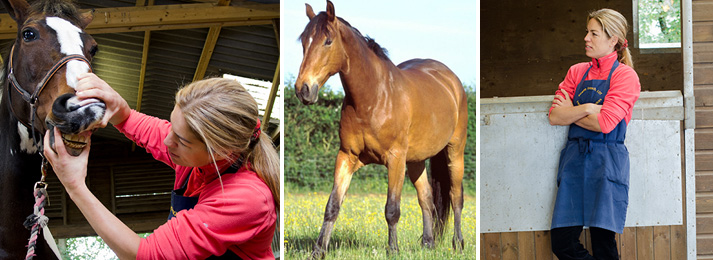FAQs
- At what age should I start getting my horse's teeth checked?
- Are there any signs I can look for that may indicate that my horse has a dental problem?
- My dentist has told me that my horse has wolf teeth, what does this mean and should I have them extracted?
- Does every horse have Canine teeth and what are they there for?
- Can you explain what a 'bit seat' is and whether all horses should have them?
- Is it true that that you can age a horse from their teeth, and if so how can you do this?
- I've heard that older horses need their teeth checked more often, why is this the case – are the teeth not the same as those in the younger horse?
- Can you explain what 'hooks' are? I have been told my horse has two in its mouth.

At what age should I start getting my horse's teeth checked?
As we all know every horse should have their teeth regularly checked and maintained to prevent any problems from arising, but the question a lot of people ask me, is at what age should this begin? The answer is nearly always - earlier than you think!
The young horse will have all their baby or deciduous teeth by the age of 6-8 months, all 24 of which will fall out to give way to their permanent teeth between the ages of 2 ½ and 4 ½ years. A further 12 permanent cheek teeth will also start erupting through the gums from the age of 1 year onwards, and stallions and geldings will get their canines at about 4 years old. Furthermore, if the horse has wolf teeth, these will erupt through between the ages of 6 to 18 months, and are easier to remove, if necessary, at a young age.
As you can see, an awful lot of activity is present in the young horse’s mouth, leading to an awful lot of potential problems. Apart from the regular sharp points that can occur, young horses can also have ‘retained caps’. These are baby teeth which have not fallen out at the correct time, blocking the permanent teeth below the gum and causing them to push in the opposite direction. In the upper jaw, they can push into and block the nasal cavity, restricting the airflow, and in the lower jaw the pressure can lead to lumps forming on the under side. Retained caps can also create imbalances within the mouth, which set up steppy and wavey conditions which may persist throughout the horse’s life. It is important that any retained caps are removed at the correct intervals to allow for the proper development of the horse’s mouth.
Generally if minor dental conditions and problems are not dealt with, they become accentuated over a period of time, leading to further more complex problems. Creating a balanced mouth helps to create a comfortable mouth that will function efficiently, only requiring regular maintenance rather than substantial amounts of work. I would therefore recommend starting your horse’s dental checks and care as early as possible to help ensure they have a balanced and healthy mouth.

Are there any signs I can look for that may indicate that my horse has a dental problem?
Below is a definitive guide to the signs to look for to indicate that your horse has dental problems, and details on how they can affect your horse.If we look at the mechanics of the mouth, we can see that horses in the wild use their teeth to forage, nip and grind their food far more frequently than most domesticated horses, who often eat for shorter periods of time, but on higher energy hard food. This lack of tooth use in our domesticated horse reduces the amount of natural wear the teeth should receive, and therefore leads to many equine dental problems. This coupled with the fact that we put a bit in the horse’s mouth, assists in explaining why it is necessary to have our horses teeth checked and maintained so often.
An uncomfortable horse will usually try to indicate the source of its pain in a variety of ways, the tricky part for us is how to interpret it correctly. The following list can be attributed to dental problems and discomfort, and should act as a rough guide of the signs to look for in your horse:
- Head throwing, shaking or tilting whilst riding If the bit is pushing sharp enamel points into the side of the cheeks, the horse will react.
- Rearing, carrying the head excessively high or backing away rapidly without being asked. Large hooks or ramps can cause immense pain to the horse with a bit in their mouth.
- Bad Odours Bad odours coming from the horse’s mouth or one of its nostrils can indicate a variety of problems, such as retained caps (baby teeth), infection, mouth sores or tooth disease.
- Long particles of food in their manure Not the best job to do, but a quick glance at your horse’s manure can show if your horse is efficiently grinding their food.
- Frustration whilst eating. Take time to watch your horse eat, any signs of frustration, dunking mouthfuls of hay in the water bucket or dropping large clumps of chewed hay, could indicate a painful mouth.
- A lack of condition.
It is always important to look at the whole picture when studying your horse’s behaviour, however, equally important is ensuring that no one area, such as the horse’s mouth, is causing them unnecessary pain. Although it is recommended that your horse’s teeth are checked by an Equine Dental Technician every six months, if you notice any of the above problems, it would be wise to call them earlier to ensure your horse is not in pain.

My dentist has told me that my horse has wolf teeth, what does this mean and should I have them extracted?
Wolf teeth are teeth in a world of their own, some horses have none, others have one or two, and some have even more! They mainly occur in the upper jaw, however on rare occasions have been known to occur in the lower jaw as well. There seems to be no trend to which horses have them as they can occur in all breeds and sexes. Interestingly, it seems that almost all Zebras have wolf teeth, however their presence in horses is not nearly as high.
Wolf teeth are actually remnants of what were once functional cheek teeth millions of years ago. They form where the cheek tooth root once was, and although they come in a variety of sizes, are always much smaller in comparison to the horse's other teeth. The diagram below shows their general position within the mouth. A common mistake is to confuse them with the canines, however, the wolf teeth sit much further back, and unlike the canines cannot be seen by just having a quick peak in the side of the mouth.
Diagram showing side view of Horse's head
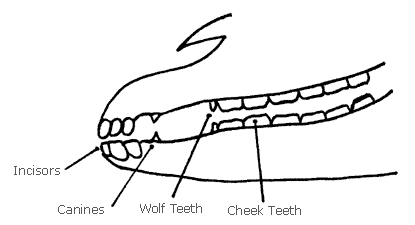 The question as to whether wolf teeth should be extracted or not depends on each individual horse. A companion horse that is never or hardly ridden will not be effected by the presence of wolf teeth. However, a horse ridden in a bit and bridle may experience discomfort and pain. The action of the bit may push the horse's fleshy cheeks against their sharp wolf teeth, irritating the horse. The horse may also feel slightly one-sided if he only has one wolf tooth present, and therefore feel uneven in the mouth. A final point is that if wolf teeth are present, it is very difficult and ineffective to install bit seats or round the front cheek teeth.
The question as to whether wolf teeth should be extracted or not depends on each individual horse. A companion horse that is never or hardly ridden will not be effected by the presence of wolf teeth. However, a horse ridden in a bit and bridle may experience discomfort and pain. The action of the bit may push the horse's fleshy cheeks against their sharp wolf teeth, irritating the horse. The horse may also feel slightly one-sided if he only has one wolf tooth present, and therefore feel uneven in the mouth. A final point is that if wolf teeth are present, it is very difficult and ineffective to install bit seats or round the front cheek teeth.
In my professional opinion, if wolf teeth are present and the horse is showing signs of discomfort whilst riding, it is wise to have them extracted. This usually resolves the problem, however, if the problem does persist the owner is safe in the knowledge that it is not due to any pain or discomfort in the mouth. Extracting wolf teeth does not involve a major operation, but does require a vet to sedate the horse. This allows the vet or equine dental technician to elevate, loosen and extract the tooth. It is then advisable not to bridle the horse for about 10 days to allow the small holes to heal.
Although we have discussed wolf teeth mainly in isolation, it is important to always consider the entire horse when making a decision. Rather than looking at just one aspect of the horse, we should consider their overall condition, behaviour and performance, and of course the general state of the rest of the mouth.

Does every horse have Canine teeth and what are they there for?
Canine teeth are also known as Tushes or Tusks.- 100% of stallions and geldings have canine teeth, 2 in the upper and 2 in the lower jaw.
- Only 25% of mares have canine teeth, which are much smaller in size and vary between 1 and 4 in quantity.
- The canine teeth appear between the ages of 4 and 5 years.
- The canine teeth are the fighting teeth, and are not used in the eating process.
- The canine teeth sit further forward in the horse's mouth than the wolf teeth, and are totally separate teeth.
- Unlike the other teeth present in the horse's mouth, when the mouth is closed the upper and lower canine teeth do not meet. The lower canines sit slightly further forward than the uppers.
- Large canines can not only cause damage to other horses during fighting, but can also cause damage to the horse's tongue and handler's hand! They can be reduced in height by your Equine Dental Technician.
- Large canines can reduce the amount of space the tongue has within the horse's mouth, leading to possible discomfort when a bit is added.
- Canines are often subject to a build up of tartar or dental plaque, which in turn can cause gum disease and pain to the horse.
Below are two photos of the same canine tooth, before and after the removal of tartar. Had the tartar not been removed, the horse would have gone on to suffer from possible gum and periodontal disease.



Can you explain what a 'bit seat' is and whether all horses should have them?
You may have recently heard your equine dental technician talk about 'Bit Seats', and wondered what they are, and how they will effect or benefit your horse. Hopefully the information below will give you a better understanding as to their role within the horse's mouth.
Side view of horse's teeth, demonstrating bit seats
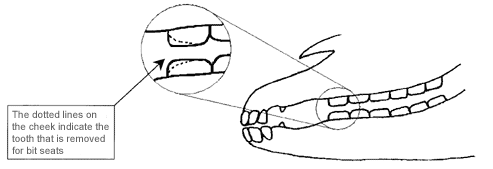 As can be seen from the diagram, installing bit seats involves rounding off the upper and lower front cheek teeth. This assists the horse in two main ways; firstly it creates more space in the mouth, giving the tongue more room when the bit is in the mouth, and secondly it smoothes the edges of the front teeth. Therefore, if the bit pushes any fleshy parts, such as the cheeks or tongue against the teeth, there are no sharp points to cause pain. Overall, bit seats are there to make riding with a bit a more comfortable experience for the horse, which in turn should lead to enhanced performance.
As can be seen from the diagram, installing bit seats involves rounding off the upper and lower front cheek teeth. This assists the horse in two main ways; firstly it creates more space in the mouth, giving the tongue more room when the bit is in the mouth, and secondly it smoothes the edges of the front teeth. Therefore, if the bit pushes any fleshy parts, such as the cheeks or tongue against the teeth, there are no sharp points to cause pain. Overall, bit seats are there to make riding with a bit a more comfortable experience for the horse, which in turn should lead to enhanced performance.When discussing the possibility of bit seats, it is important to advise your equine dental technician of the type of bit you ride in. Just as different bits have different effects on the horse, they will also determine the style of bit seat most appropriate. Once the bit seats are installed, they are fairly easy to maintain during regular dental maintenance. However, due to the amount of tooth height reduced and thus pressure on the horse's jaw, they are often easier to initially install using power equipment.
Finally, it is important to note that whilst bit seats were designed with the horse's comfort and performance in mind, not all horses will benefit from them. Some horses will show no change in behaviour whilst others will greatly appreciate the difference which will reflect in their riding.
Although bit seats can assist the horse, they are no substitute for regular dental maintenance, which should be performed every 6 months.

Is it true that that you can age a horse from their teeth, and if so how can you do this?
In order that we are asking our horse to perform tasks in line with their age and ability, and caring for them in the appropriate manner, it is important to know roughly how old they are. As this information may not always be known, we need a method of ageing the horse from the clues within the horse itself.
Factors such as the horse’s condition, appearance and confirmation can act as an age guide, but perhaps the best indicator comes from studying their teeth. The rate the young horse’s teeth erupt through the gum-line depends on the age of the horse, therefore, by noting which baby or adult teeth are present, enables us to age the horse up to 5 years. After this, it is possible to look at the shape and surface of the incisors to give us a rough guide to their age.
In ageing the younger horse, we look for the infundibulum or cups, which are shown as large dark circles on the surface of the incisor tooth. As the tooth is worn down, this disappears from view from the lower central incisor to the upper edge incisor between the ages of 6 and 11 years. There are similar markings in the older horse, known as dental spots. These are smaller dark spots and will disappear from view between the ages of 13 and 20 years.
Many other age indicators are present on the horse’s teeth, such as the dental star, a small mark appearing on the incisor surface at about 8 years of age, and the Galvayne’s Groove, a small indent running down the side of the upper corner incisor, appearing at 10 years and reaching the bottom by 20 years. The shape and angle of the incisors should also be studied, as the steeper the angle and the more triangular shaped the tooth, the older the horse.
In ageing a horse accurately however, it is important to always look at the whole picture and not just one factor in isolation. Although there are guidelines depicting how a horse’s teeth should appear at a certain age, the breed, diet, lifestyle and previous dental care will all have an influence on the teeth. Nevertheless, if all the above points are taken into consideration, it is possible to gain an idea, within a few years, of the horse’s age.

I've heard that older horses need their teeth checked more often, why is this the case – are the teeth not the same as those in the younger horse?
Having provided us with a lifetime of loyal service, the older horse deserves some extra care and attention in later life. This applies to many aspects of the horse, including their teeth and mouth.
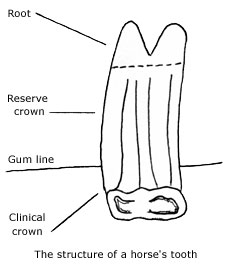 To understand how age effects the horse's teeth, we need to look at the tooth structure. From the diagram below we can see that the teeth are made up of three main sections - the clinical crown, which is the part of tooth present in the mouth, - the reserve crown, which is the part of the tooth below the gum line and the root. As the clinical crown is worn down through eating, the reserve crown erupts through the gum line, ensuring a constant amount of tooth height in the horse's mouth. However, there is only a certain amount of reserve crown, and once this has worn down (expired), the horse is simply left with the root of the tooth. The root, unlike the crown, does not contain any enamel, causing this softer tooth surface to wear down in the middle from the grinding of the food, this is known as 'cupping away'. If this occurs it may be difficult for the horse to grind their food effectively, preventing them from getting the most nutrition from their food. In cases such as this, it may be necessary to soak food such as nuts and cubes, to assist with their eating.
To understand how age effects the horse's teeth, we need to look at the tooth structure. From the diagram below we can see that the teeth are made up of three main sections - the clinical crown, which is the part of tooth present in the mouth, - the reserve crown, which is the part of the tooth below the gum line and the root. As the clinical crown is worn down through eating, the reserve crown erupts through the gum line, ensuring a constant amount of tooth height in the horse's mouth. However, there is only a certain amount of reserve crown, and once this has worn down (expired), the horse is simply left with the root of the tooth. The root, unlike the crown, does not contain any enamel, causing this softer tooth surface to wear down in the middle from the grinding of the food, this is known as 'cupping away'. If this occurs it may be difficult for the horse to grind their food effectively, preventing them from getting the most nutrition from their food. In cases such as this, it may be necessary to soak food such as nuts and cubes, to assist with their eating.
Other problems that can occur in older horses include periodontal disease, gum disease (gingivitis), loose teeth leading to food getting impacted in the mouth and missing teeth. The teeth may also have a tendency to lean to the outside, pressing against the horse's cheeks, or the inside towards their tongue. These problems can be corrected with good dental procedures, however due to the limited amount of tooth life left in the older horse's mouth, it is often better to adjust the mouth to best suit the horse in question, rather than attempting to give the horse a text book perfect mouth.
Although it is not possible to stop the ageing process, it is possible to help the older horse, by having their teeth regularly checked and maintained, preferably every six months. It is also important to note however, that teeth benefiting from a lifetime of care, will better assist the horse in later life, therefore regardless of age, all horses will benefit from regular dental care.

Can you explain what 'hooks' are? I have been told my horse has two in its mouth.
No doubt we all agree that the horse is an amazing creature. This not only applies to their nobility and grace, but also their ability, despite any problems they may have, to carry on eating! Take mouth sores for instance, if we had mouth ulcers we would probably gargle with mouthwash, apply Bonjela, and generally let everyone around us know of our pain. On the other hand, if a horse had a mouth sore, they would no doubt continue eating, whilst showing no obvious signs of discomfort in their behaviour or condition!
Amongst the most common dental problems that can occur, are what are known as Hooks and Ramps. These do not refer to fishing tackle or skate parks, but to unnaturally high sections of teeth within the mouth, that can cut into the cheeks or tongue, and cause immense pain.
The Horse's Mouth Showing Hooks and Ramps
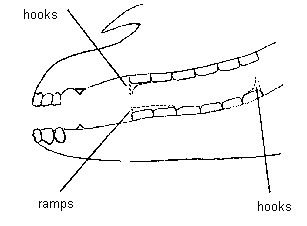
Hooks and Ramps vary greatly in their exact location, size and shape, and without dental treatment, create an imbalance and prevent the natural movement of the jaw. As the Hooks have nothing to grind against, they continue to erupt, becoming larger, sharper and more uncomfortable in the horse's mouth. As with many dental problems however, unless you open their mouths and have a good look, they can easily go undetected.
The presence of Hooks and Ramps can also effect the horse's riding. For example, when we ask the horse to go on the bit, amongst other things we are asking them to round and hold their head in a vertical position. When we ask for this, the lower jaw should naturally slide forward allowing their incisors and cheek teeth to meet, however, with hooks present such as those in the diagram, it would be extremely difficult and uncomfortable for the horse to reach this position with their mouth closed. Therefore, they are often left with no alternative but to open their mouth, to relieve the pain.
Although horses often try to tell us how they are feeling in their own unique way, it is not always easy to interpret. With regard to their mouths, they may look well and be eating fine, however without calling in Doctor Dolittle, the only real way to check for problems is to have the teeth checked regularly by a qualified Equine Dental Technician.

